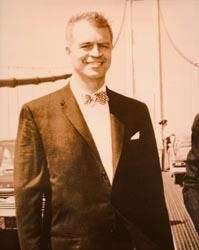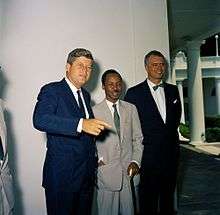G. Mennen Williams
| G. Mennen Williams | |
|---|---|
 | |
| 41st Governor of Michigan | |
|
In office January 1, 1949 – January 1, 1961 | |
| Lieutenant |
John W. Connolly (1949-1951) William C. Vandenberg (1951-1953) Clarence A. Reid (1953-1955) Philip A. Hart (1955-1959) John B. Swainson (1959-1961) |
| Preceded by | Kim Sigler |
| Succeeded by | John Swainson |
| Personal details | |
| Born |
Gerhard Mennen Williams February 23, 1911 Detroit, Michigan |
| Died |
February 2, 1988 (aged 76) Detroit, Michigan |
| Political party | Democratic |
| Spouse(s) | Nancy Lace Quirk |
| Alma mater | University of Michigan |
| Religion | Episcopalian |
Gerhard Mennen "Soapy" Williams (February 23, 1911 – February 2, 1988) was the 41st Governor of Michigan, elected in 1948 and serving six two-year terms in office. He later served as Assistant Secretary of State for African Affairs under President John F. Kennedy and Chief Justice of the Michigan Supreme Court.
As assistant secretary of state, his remark that "what we want for the Africans is what they want for themselves," reported in the press as "Africa for the Africans," sparked controversy at the time.[1]
Williams was described by the Chicago Tribune as a political reformer who "helped forge the alliance between Democrats, blacks and union voters in the late 1940s that began a strong liberal tradition in Michigan."[2]
Personal life and early career
Gerhard Mennen Williams was born in Detroit, Michigan, to Henry P. Williams and Elma Mennen. His mother came from a prominent family; her father, Gerhard Heinrich Mennen,[3] was the founder of the Mennen brand of men's personal care products. Because of this, Williams acquired the popular nickname "Soapy."[4]
Williams attended the Salisbury School in Connecticut, an exclusive Episcopal preparatory school. He graduated from Princeton University in 1933 and received a law degree from the University of Michigan Law School.[5] While at law school, Williams became affiliated with the Democratic Party, departing from his family's strong ties to the Republican Party.
Williams met Nancy Quirk on a blind date while attending the university. She was the daughter of D. L. Quirk and Julia (Trowbridge) Quirk, a prominent Ypsilanti family involved in banking and paper milling. Her brother, Daniel Quirk, was later mayor of Ypsilanti . The couple married in 1937 and had three children; a son, G. Mennen Williams Jr., and two daughters, Nancy Ketterer III and Wendy Stock Williams.
He worked with the law firm Griffiths, Williams and Griffiths from 1936 to 1941. Law firm partners included Hicks Griffiths and Martha Griffiths, later elected a Member of Congress and Michigan Lt. Governor.
During World War II, he served four years in the United States Navy as an air combat intelligence officer in the South Pacific. He achieved the rank of lieutenant commander and earned ten battle stars. He later served as the deputy director of the Office of Price Administration from 1946 to 1947, and was named to the Michigan Liquor Control Commission in 1947.
Governor of Michigan

On November 2, 1948, Williams was elected Governor of Michigan, defeating Governor Kim Sigler with the support of labor unions and dissident Republicans. He was subsequently elected to a record six two-year terms in that post. Among his accomplishments was the construction of the Mackinac Bridge. He appeared on the cover of Time's September 15, 1952, issue, sporting his signature green bow tie with white polka dots.
Williams gained prominence for his refusal in 1950 to extradite Haywood Patterson, one of the Scottsboro Boys, who had escaped from prison in Alabama in 1948 and hidden in Detroit for two years.[6]
Also during his twelve years in office, a farm-marketing program was sanctioned, teachers' salaries, school facilities and educational programs were improved and there were also commissions formed to research problems related to aging, sex offenders and adolescence behavior.
Williams named the first woman judge in the state's history as well as the first black.[2] As a delegate to the Democratic National Convention in 1956, he unsuccessfully sought the vice-presidential nomination. At the 1952, 1956 and 1960 conventions he fought for insertion of a strong civil rights plank in the party platform. He strongly opposed the selection of Lyndon Baines Johnson as vice president in 1960, feeling that Johnson was "ideologically wrong on civil rights." Williams made public his opposition, shouting "No" when a call was made for Johnson's nomination to be made unanimous. He was the only delegate to publicly oppose Johnson's nomination.[7]
His final term in office was marked by high-profile struggles with the Republican-controlled state legislature and a near-shutdown of the state government. He therefore chose not to seek reelection in 1960. Williams left office on January 1, 1961, his 12 years in office ultimately surpassed only by William Milliken (who served 14 years as governor).
Post-gubernatorial years

After leaving office in 1961, Williams assumed the post of Assistant Secretary of State for African Affairs in the administration of President John F. Kennedy. His remark at a press conference that "what we want for the Africans is what they want for themselves," reported in the press as "Africa for the Africans," sparked controversy. Whites in South Africa and Rhodesia, and in the British and Portuguese colonies contended that Williams wanted them expelled from the continent. Williams defended his remarks, saying that he included white Africans as Africans. Williams was defended by Kennedy at a press conference, saying that "Africa for the Africans does not seem to me to be an unreasonable statement." Kennedy said that Williams made it clear he was referring to Africans of all colors, and "I don't know who else Africa should be for." [8]
He served in this post until early 1966, when he resigned to unsuccessfully challenge Republican United States Senator Robert P. Griffin. Two years later, he was named by President Lyndon B. Johnson to be U.S. ambassador to the Philippines, where he served less than a year.
In 1969 he wrote a book on the emergence of modern Africa, Africa for the Africans.
Williams was elected to the Michigan Supreme Court in 1970 and was named Chief Justice in 1983. Thus, like William Howard Taft in the federal government, he occupied the highest executive and judicial offices in Michigan government.
Retirement and death
Williams left the Court on January 1, 1987, and died the following year in Detroit at the age of 76, just three weeks before his 77th birthday. He was temporarily entombed at Evergreen Cemetery in Detroit and there was a formal military funeral for him. After winter his remains were interred at the Protestant Cemetery on Mackinac Island. His New York Times obituary said of Williams's diplomatic service: "Traveling widely, he studied the needs of countries in the birth pangs of independence and brought their pleas for American investment and trust to Washington."[9]
Honors
The state government's law building, G. Mennen Williams Building in Lansing, constructed in 1967, was dedicated in Williams's honor in 1997.[10]
A G. Mennen Williams dinner is an annual event held by the Ionia County Democratic Party each July at the World's Largest Free Fair in Ionia, Michigan. Originally called the Democratic Tent Dinner at its start in the mid-40s, it was renamed after Soapy in 1988 as a way to pay homage to the man that paved the way for dinners to be held at the fair. The Ionia Republican Party had held dinners at the fairgrounds during the 1940s, but the Democrats could not until Soapy stepped up and gained the party equal access in 1949.
A portion of Interstate 75 in Cheboygan and Mackinac counties is known as the G. Mennen Williams Highway.[11]
At Detroit Mercy Law (formerly: University of Detroit Mercy School of Law), the Moot Court Board of Advocates hosts the annual G. Mennen Williams Moot Court Competition[12] for all first-year students through their Applied Legal Theory and Analysis course. First year students draft a dispositive motion and brief in support as part of their writing course, and argue their position before a mock tribunal.
Notes
- ↑ Noer, Thomas (2006). Soapy: A Biography of G. Mennen Williams. Ann Arbor, MI: University of Michigan Press. ISBN 978-0-472-03186-3.
- 1 2 Franklin, Stephen (3 February 1988). "G. Mennen Williams, Ex-michigan Governor". Chicago Tribune. Retrieved 28 December 2013.
- ↑ Buried at Fairmount Cemetery (Newark, New Jersey)
- ↑ Saxon, Wolfgang (February 3, 1988). "G. Mennen Williams, 76, Is Dead". New York Times. Retrieved 28 December 2014.
- ↑ Hanley, James P. (2007). Politics and Government in Michigan (5th ed.). Boston: McGraw Hill. p. 91. ISBN 978-0-07-338783-3.
- ↑ Annette Gordon-Reed, ed. (2002). Race on Trial: Law and Justice in American History. Oxford University Press. p. 137.
- ↑ Noer, pp. 165, 210, 215
- ↑ Noer, p. 239-240
- ↑ Saxon. "G. Mennen Williams, 76, Is Dead".
- ↑ "G. Mennen Williams Building". SkyscraperPage.com. Retrieved 28 December 2013.
- ↑ "Memorial Highways". State of Michigan Department of Transportation. Retrieved 28 December 2013.
- ↑ "Competitive Opportunities; Internal Competitions". University of Detroit Mercy Law. Retrieved 8 November 2016.
References
- Michigan Supreme Court Historical Society
- Michigan Lawyers in History
- Find a Grave Memorial
- National Governors Association
- Political Graveyard
- Time Magazine Cover September 15, 1952
Further reading
- "The Mighty Mac at 50", Michigan History Magazine (Special edition), Volume 19, No. 4, July–August, 2007.
| Political offices | ||
|---|---|---|
| Preceded by Kim Sigler |
Governor of Michigan 1949–1961 |
Succeeded by John Swainson |
| Government offices | ||
| Preceded by Joseph C. Satterthwaite |
Assistant Secretary of State for African Affairs February 1, 1961 – March 23, 1966 |
Succeeded by Joseph Palmer II |
| Diplomatic posts | ||
| Preceded by William McCormick Blair, Jr. |
U.S. Ambassador to the Philippines 1968–1969 |
Succeeded by Henry A. Byroade |
